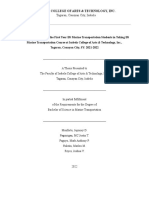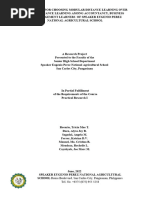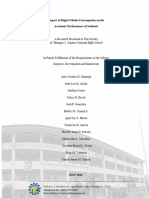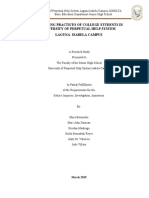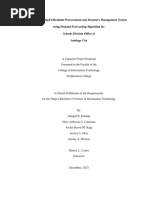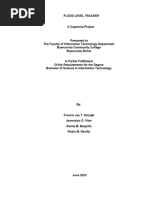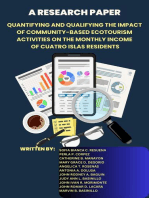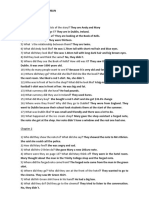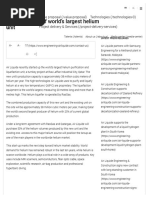Chapter 1-3
Chapter 1-3
Uploaded by
NSTP CWTSCopyright:
Available Formats
Chapter 1-3
Chapter 1-3
Uploaded by
NSTP CWTSOriginal Title
Copyright
Available Formats
Share this document
Did you find this document useful?
Is this content inappropriate?
Copyright:
Available Formats
Chapter 1-3
Chapter 1-3
Uploaded by
NSTP CWTSCopyright:
Available Formats
Colegio de San Juan de Letran-Manaoag
Castro St. Poblacion, Manaoag, Pangasinan, Philippines
BACHELOR OF SCIENCE IN INFORMATION TECHNOLOGY
Web-Based Management Information System
through the use of Integrated Mapping in
Forest Lake Memorial Park
A Capstone Project
Presented to the Faculty of the
Information and Communications Technology Program
Colegio de San Juan de Letran-Manaoag
In Partial Fulfillment
Of the Requirements for the Degree
Bachelor of Science in Information Technology
Jefaelson T. De Francia
Alann Mac Joy B. Estrada
Rodulfo E. Estrada Jr.
Ace Marcos D. Fernandez
Kelly Mark A. Garcia
Jhordan F. Lelis
DEUS ● PATRIA ● LETRAN
Colegio de San Juan de Letran-Manaoag
Castro St. Poblacion, Manaoag, Pangasinan, Philippines
BACHELOR OF SCIENCE IN INFORMATION TECHNOLOGY
EXECUTIVE SUMMARY
The Web-Based Management Information System with Integrated Mapping is a
system that aims to provide a platform for the user to quickly locate and less effort into
finding their relative graves using digital mapping strategies and a platform for the
personnel to access, update, and efficiently maintain the data with the use of an
information system. The researchers decided to make the system for the Forest Lake
Memorial Park in Manaoag, Pangasinan.
To achieve the goals of the project, the researchers will use an interactive web-
based information system as a platform in which both the end users and personnel of the
cemetery/memorial garden can look up information about a particular grave easily and
efficiently. With the current system used, the personnel and visitors, mostly ones who
haven’t visited their loved ones for a long time, manually locate, search, and record the
information and location of the deceased person which is time-consuming and takes a lot
of effort in order the work to be done.
The researchers thought that the current system was already outdated, so they will
recreate it to be an easier, more efficient, and hassle-free system. The information about
the deceased person will be stored in this system, both the user and the personnel will
simply search the deceased name of the person and then the information about that person
will pop up on the screen, such as the location and other information about them, and the
system makes personnel and user experience hassle-free searching in contrast with the
current system.
Implementing this project will help; (1) the administration of the memorial garden
with the information about the graves, i.e. the name of the deceased and the year they
passed away, and (2) the visitors with locating their loved ones’ graves.
APPROVAL SHEET
DEUS ● PATRIA ● LETRAN
Colegio de San Juan de Letran-Manaoag
Castro St. Poblacion, Manaoag, Pangasinan, Philippines
BACHELOR OF SCIENCE IN INFORMATION TECHNOLOGY
This Thesis entitled: Web-Based Management Information System through the Use
of Integrated Mapping in Forest Lake Memorial Park prepared and submitted by
Jefaelson T. De Francia, Alann Mac Joy B. Estrada, Rodulfo E. Estrada, Jr. Ace
Marcos D. Fernandez, Kelly Mark A. Garcia, Jhordan F. Lelis in partial fulfillment of
the requirements for the degree of Bachelor of Science in Information Technology, has
been examined and is recommended for acceptance and approval for Oral Defense.
Eugene A. Estacio
Capstone Project Adviser
PANEL OF EXAMINERS
Accepted by the Committee on Oral Examination with a grade of ______.
MR. JOHN IVAN S. CLEOFE, LPT, MST
Chairman
MR. EUGENE A. ESTACIO MS. KRISTIN MAE S. SERAFICA
Member Member
Accepted and approved in partial fulfillment of the requirements for
BSIT-III/Capstone Project.
MS. MARY ROSE S. BANDONG, LPT
OIC, Research and Publication Department
Date: _______
MR. JOHN IVAN S. CLEOFE, LPT, MST
Dean of College
Date: ________
ACKNOWLEDGEMENTS
The Researchers would like to extend their heartfelt gratitude to the following
persons who helped us make this Capstone Project a reality:
Mr. Eugene A. Estacio, Adviser, thank you for your painstaking effort in correcting
the research, orienting, guiding, facilitating, motivating, and providing wise counsel.
DEUS ● PATRIA ● LETRAN
Colegio de San Juan de Letran-Manaoag
Castro St. Poblacion, Manaoag, Pangasinan, Philippines
BACHELOR OF SCIENCE IN INFORMATION TECHNOLOGY
Mr. John Ivan S. Cleofe, Ms. Kristin Mae Serafica, and Mr. Eugene A. Estacio,
Panelists, we thank you from the bottom of our hearts for taking time from your busy
schedule to be the Guest Speaker/Panelists at our Capstone Project Finals. Your presence
and wise words will help magnify our cause in the best possible way.
Our Friends and Classmates, for having helping hands to extend the time of needs
and problems we met while conducting the project.
Our Parents for being very understanding, providing excellent love and inspiration
to us, and giving full support financially, morally, physically, emotionally, and spiritually;
and
The Almighty Father, for giving us divine knowledge, divine understanding, divine
light, and divine wisdom to make the study a reality.
JEFAELSON T. DE FRANCIA
ALANN MAC JOY B. ESTRADA
RODULFO E. ESTRADA JR.
ACE MARCOS D. FERNANDEZ
KELLY MARK A. GARCIA
JHORDAN F. LELIS
DEDICATION
To our parents, this research work is devoted.
They are the ones who motivate us and support us wholeheartedly in doing this study they
are what keeps us from not giving up.
DEUS ● PATRIA ● LETRAN
Colegio de San Juan de Letran-Manaoag
Castro St. Poblacion, Manaoag, Pangasinan, Philippines
BACHELOR OF SCIENCE IN INFORMATION TECHNOLOGY
Additionally, we dedicate this research paper to Mr. Eugene A. Estacio, our subject
teacher, who is always willing to put forth the effort to learn and advance this project, as
well as to our friends, whose assistance in finishing it has been greatly appreciated.
Last but not least, we offer this research paper as a dedication to Our God the Almighty,
who bestows us strength, wisdom, encouragement, and good health.
DEUS ● PATRIA ● LETRAN
Colegio de San Juan de Letran-Manaoag
Castro St. Poblacion, Manaoag, Pangasinan, Philippines
BACHELOR OF SCIENCE IN INFORMATION TECHNOLOGY
Table of Contents
Table of Contents..................................................................................................................................
CHAPTER I.............................................................................................................................................
INTRODUCTION
1.1 PURPOSE AND DESCRIPTION OF THE PROJECT
1.2 STATEMENT OF THE PROBLEM
1.3 OVERVIEW OF THE CURRENT STATE OF TECHNOLOGY
1.4 OBJECTIVES...................................................................................................................................
1.4.1 General Objectives
1.4.2 Specific Objectives
1.6 SCOPES AND LIMITATIONS............................................................................................................
1.6.1 Scopes
1.6.2 Limitations
CHAPTER II..........................................................................................................................................
REVIEW OF RELATED LITERATURE
2.1 RELATED STUDIES AND/OR SYSTEMS............................................................................................
2.1.1 Foreign
2.1.2 Local
2.2 SYNTHESIS.....................................................................................................................................
2.2.5 Strength of Previous Work
2.3 Bridging the Gap............................................................................................................................
DEUS ● PATRIA ● LETRAN
Colegio de San Juan de Letran-Manaoag
Castro St. Poblacion, Manaoag, Pangasinan, Philippines
BACHELOR OF SCIENCE IN INFORMATION TECHNOLOGY
CHAPTER III TECHNICAL BACKGROUND..............................................................................................
3.1 OVERVIEW OF CURRENT TECHNOLOGIES TO BE USED IN THE SYSTEM........................................
3.2 RESEARCH DESIGN........................................................................................................................
3.3 RESEARCH QUESTIONNAIRE..........................................................................................................
3.4 SAMPLE POPULATION AND SAMPLE SIZE......................................................................................
3.5 SAMPLING PROCEDURE AND SAMPLING SELECTION....................................................................
3.6 CALENDAR OF ACTIVITIES..............................................................................................................
Table 1 Chart of Activities
3.7 RESOURCES...................................................................................................................................
Table 2 Recommended Hardware/Software Specification
DEUS ● PATRIA ● LETRAN
Colegio de San Juan de Letran-Manaoag
Castro St. Poblacion, Manaoag, Pangasinan, Philippines
BACHELOR OF SCIENCE IN INFORMATION TECHNOLOGY
CHAPTER I
INTRODUCTION
Cemeteries play a significant role in any community, serving as a place for
remembrance and mourning. Proper planning and maintenance are crucial to continue
fulfilling their vital functions. Cemeteries have been an essential part of civilized
societies, as proper disposal of the dead is necessary for sanitation and cultural well-
being.
Previously, cemetery property maps were hand-drawn or created using cartographic
software on a fixed scale, and records were kept on paper. The related attribute data was
also recorded manually in paper books or spreadsheets and updated similarly. This
traditional method of cemetery mapping and record management is time-consuming,
tedious, and cost-effective. Besides, hard-copy property maps and attribute data are not
connected, making it challenging to update and manage records.
In addition, paper maps and files are hard to store and carry, and they can be easily
misplaced, ripped, or stolen. Paper materials deteriorate over time and are susceptible to
fires and water-related disasters. Pencil markings fade over time and are easily smudged.
Furthermore, the actual information contained within these records varies, and the lack of
standardization means that essential information may not be recorded (Bennett & Davies,
2015; Schmidt, 2018).
The universal definition of cemetery mapping is “the act of understanding the
layout of grave sites and other elements within a cemetery and documenting those
locations.”. It is an important process that helps manage the cemetery’s data and land
information.
An information system (IS), on the other hand, is an interconnected set of
components used to collect, store, process, and transmit data. It can also be used to
DEUS ● PATRIA ● LETRAN
Colegio de San Juan de Letran-Manaoag
Castro St. Poblacion, Manaoag, Pangasinan, Philippines
BACHELOR OF SCIENCE IN INFORMATION TECHNOLOGY
analyze problems, visualize complex subjects, and many others.
In this matter, the proponents will develop a Web-Based Information System with
an Integrated Mapping System for Forest Lake Memorial Park. The system will be used
for navigating or locating the relative’s grave in the cemetery and also providing them a
full information on how long their relatives have been deceased. The Information System
will be handling all of the records of every deceased person who is buried in Forest Lake
Memorial Park.
People nowadays, especially on All Saint’s Day and All Soul’s Day. They visit
their loved ones for the memories and have quality time. There’s a time when they can’t
find the graves they are confused and it takes time for too long to find the graves of their
loved ones. Especially on the elders, they can’t find it easily because they are old. It will
be hard for them because they will ask other people where the place of the grave. And
also, visitors from abroad or other cities, can't find it easily so it's hard for them also.
Lastly, the web-based information management system with integrated mapping
will have huge benefits for the admin and the users of the Forest Lake Memorial Park. It
helps them to find graves easily, hassle-free, and not time-consuming. The system will
help the admin to update the system when it needs to be updated. It can be easy for them
to locate the land for reservation.
DEUS ● PATRIA ● LETRAN
Colegio de San Juan de Letran-Manaoag
Castro St. Poblacion, Manaoag, Pangasinan, Philippines
BACHELOR OF SCIENCE IN INFORMATION TECHNOLOGY
1.1 PURPOSE AND DESCRIPTION OF THE PROJECT
The goal of the Web-Based Management Information System with Integrated
Mapping is to give users a way to easily and quickly locate their relatives' graves through
the use of digital mapping techniques, as well as a way for staff members to access,
update, and maintain data efficiently through the use of an information system. The
technique was created by the researchers specifically for the Forest Lake Memorial Park
located in Manaoag, Pangasinan.
1.2 STATEMENT OF THE PROBLEM
This Capstone Project can help the Forest Lake Memorial Park Admins and Users
to have the easiest access to the information and graves of one person who is buried.
● Traditionally, visitors have manually locating the graves of their loved ones. What
is the best way to lessen the problem of the visitors?
● What steps are taken to ensure the mapping system is user-friendly and accessible
to visitors and elders of Forest Lake Manaoag?
● What other benefits does the proposed system offer to the cemetery to enhance its
sales?
● What features that is different from your system to others?
1.3 OVERVIEW OF THE CURRENT STATE OF TECHNOLOGY
Due to the observation and interview of the researchers. The Forest Lake Memorial
Park is not finished. There’s a part that is still under construction. The researchers observe
that the Memorial Park has not been buried yet.
DEUS ● PATRIA ● LETRAN
Colegio de San Juan de Letran-Manaoag
Castro St. Poblacion, Manaoag, Pangasinan, Philippines
BACHELOR OF SCIENCE IN INFORMATION TECHNOLOGY
It focuses more on Land Reservations and other services. The researchers observe
that the Memorial Park has not been mapped yet. So, the researchers ask for permission to
create a mapping system for the memorial park. To have the easiest way to find the
graves of everyone who was buried in the memorial park.
1.4 OBJECTIVES
1.4.1 General Objectives
The main concern of this Capstone Project is to develop a system that determines
all the information about the deceased persons in Forest Lake Memorial Park. And to help
the end users locate the grave/s of their deceased relatives without having a physical map.
1.4.2 Specific Objectives
The major purpose of this research is to design and develop an Information
Management system and have Integrated Mapping for the Forest Lake Memorial Park. To
make end user and administration perform their task easier and not that complicated. To
create a system that will make the organization's performance satisfactory and excellent.
● The system utilizes GPS technology to precisely locate each graves, ensuring
accuracy.
● The system is designed to be easily accessible and user-friendly for the visitors
and elders of Forest Lake Manaoag.
● By adding advertisement promotion into the system to enhance the experience for
the users visiting Forest Lake Manaoag.
● Having a mapping system that helps visitors and elders to easily find the graves of
their loved ones.
DEUS ● PATRIA ● LETRAN
Colegio de San Juan de Letran-Manaoag
Castro St. Poblacion, Manaoag, Pangasinan, Philippines
BACHELOR OF SCIENCE IN INFORMATION TECHNOLOGY
1.6 SCOPES AND LIMITATIONS
The study focuses on Cemetery Mapping and Information System for Forest Lake
Memorial Park. The system plays an important role for the Visitors, Customers, and
employees in Forest Lake Memorial Park. The system has a map to guide and help the
visitors to visit their loved one’s grave, it also shows the Information of specific graves.
The system can also keep important records and information of one grave. Including the
Name, Lot, Block, Age, Date of deceased, and birthday.
1.6.1 Scopes
The study will take an estimated of a whole month to complete as we must examine
its gravesites. We are only limited to those locations and prohibited from entering
personnel-only areas and construction zones. The system will also include:
● Memorial Park Information
1. Contact details, rules and regulations, and visiting hours.
2. Services offered.
● Interactive Mapping
1. Searchable map of the memorial park.
2. User-friendly interface for navigating the map.
1.6.2 Limitations
Drafting of the cemetery’s areas will be needed to navigate where to go. By doing
so, we will organize how we can design a wireframe of what the management system will
look like during the design phase.
DEUS ● PATRIA ● LETRAN
Colegio de San Juan de Letran-Manaoag
Castro St. Poblacion, Manaoag, Pangasinan, Philippines
BACHELOR OF SCIENCE IN INFORMATION TECHNOLOGY
The accuracy and completeness of the information will depend on the data provided
by the park management. This system will focus on informational and navigational
purposes and will not include features like memorial purchase or management.
DEUS ● PATRIA ● LETRAN
Colegio de San Juan de Letran-Manaoag
Castro St. Poblacion, Manaoag, Pangasinan, Philippines
BACHELOR OF SCIENCE IN INFORMATION TECHNOLOGY
CHAPTER II
REVIEW OF RELATED LITERATURE
A literature review can be defined as a review of the researcher's previous work on
the current system as well as a review of the system that will be established. A literature
study also focuses on the established knowledge and opinions on a topic, as well as their
strengths and limitations. Nowadays, technology is improving and replacing conventional
systems to speed up the process by integrating automated systems.
2.1 RELATED STUDIES AND/OR SYSTEMS
2.1.1 Foreign
https://www.researchgate.net/publication/
366118430_Development_of_Muslim_Graveyard_Management_System_MGMS_Using
_Geospatial_Technology_Applications
Development of Muslim Graveyard Management System (MGMS) Using Geospatial
Technology.
According to Abdullah, S., Hussain, N. H. M., Talib, N., Hashim, I. C., Hashim, H., &
Osoman, M. A. (2022). Nowadays the internet is the most up-to-date and convenient
source of information. Apart from the Internet, Geographic information systems (GIS) are
also the foundation for the Muslim Graveyard development system. The public and the
Islamic Religious Department will benefit from the establishment of the GIS database and
the Muslim Cemetery Web. This system is sufficient, provides convenience, and is
reliable to everyone, especially to the heirs during their visits to the family grave at the
Muslim cemetery. This established system can deliver grave information to anyone and
aid in faster and more effective processing of death records.
https://www.researchgate.net/publication/
345913018_Cemetery_Mapping_and_Digital_Data_Analysis_A_Case_Study_in_Minnes
ota_USA
Cemetery Mapping and Digital Data Analysis: A Case Study in Minnesota, USA
DEUS ● PATRIA ● LETRAN
Colegio de San Juan de Letran-Manaoag
Castro St. Poblacion, Manaoag, Pangasinan, Philippines
BACHELOR OF SCIENCE IN INFORMATION TECHNOLOGY
Maureen L. Schmidt, Fei Yuan, Woo Jang (August 2020) stated that this study set out to
investigate how, given a restricted amount of time and funding, geospatial technologies
might be utilized to convert local cemetery information into a digital geodatabase. It was
discovered that with well-thought-out GPS data collection procedures, a high degree of
locational precision could be attained.
https://publisher.uthm.edu.my/periodicals/index.php/aitcs/article/view/7697
Development of Grave Tracker System.
According to Mohamad Rozi, M. N., & Mohamad, R. (2023). Grave Tracker is a web-
based system that works to track and record the information about the grave at Kg
TengluLaut, Mersing Johor. The proposed system aims to improve the weakness of the
existing method which is the use of books as a medium to record information about
graves. Generally, the Grave Tracker was built to increase the effectiveness and
efficiency in managing the collection of data or information by the grave management at
Tanah Perkuburan Kg TengluLaut.
https://dl.acm.org/doi/abs/10.1145/3406535
Digital Mapping of Medieval Cemeteries: Case Studies from Austria and Czechia
According to Stefan Eichert (2020). The presented article discusses how to digitize data
on burials and how to provide them to the public in sustainable and comprehensible ways.
Within previous and ongoing projects, the author and his team have developed a database
system (OpenAtlas) that is used for the data acquisition of archaeological and
anthropological research data that also maps information directly to the CIDOC CRM.
Temporal and spatial fuzziness are dealt with following various concepts such as
GeoJSON-T. For providing the data as Linked Open Data, the “linked places” format is
used and an API provides a JSON-LD representation of each entity. Due to the “standard”
DEUS ● PATRIA ● LETRAN
Colegio de San Juan de Letran-Manaoag
Castro St. Poblacion, Manaoag, Pangasinan, Philippines
BACHELOR OF SCIENCE IN INFORMATION TECHNOLOGY
approach implemented when publishing cemeteries, data acquisition is mostly achieved
by manually recording the published information in the database.
https://www.frontiersin.org/articles/10.3389/frsc.2021.789925/full
Planning Cemeteries: Their Potential Contribution to Green Infrastructure and
Ecosystem Services
According to Katie McClymont, and Danielle Sinnett (2021). Cemeteries are currently
playing a role as green infrastructure, but precisely what role this is, whether this can be
enhanced, and whether in so doing this interferes with their purpose of sacred spaces of
remembrance needs further consideration. This includes questions of maintenance. When
new cemetery space is required, the identification of suitable locations needs to
proactively balance these environmental and social/cultural needs.
https://www.researchgate.net/publication/
337529171_Visiting_a_virtual_graveyard_designing_virtual_reality_cultural_heritage_ex
periences
Visiting a local graveyard: designing virtual reality cultural heritage experiences.
According to Jonna Hakkila, Ellina Luiro, Sanni Mustonen, Toni Westerlund, Ashley
Colley, Petri Hannula, and Emilia Launne (2019). They aimed to create a as realistic as
possible virtual environment, but study participants still wished for more detail and
authenticity. Comparison between hand-controller button-based walking and
teleportation-based navigation was inconclusive, with pros and cons being noted for both
approaches. The need for dignity in such sensitive cultural heritage environments was
highlighted, e.g. a virtual candle should be respectfully placed on a grave, rather than
dropped.
DEUS ● PATRIA ● LETRAN
Colegio de San Juan de Letran-Manaoag
Castro St. Poblacion, Manaoag, Pangasinan, Philippines
BACHELOR OF SCIENCE IN INFORMATION TECHNOLOGY
https://zendy.io/pdf-viewer/10.5194%2Fisprs-archives-xlii-5-59-2018
SEMI-AUTOMATED CEMETERY MAPPING USING SMARTPHONES
Nusret Demir, and Nithiyanandam Yogeswaran (2018) stated that the study aims to
address this problem by geotagging individual graves using a smartphone. The developed
method allows the user to click pictures of the grave, add information like name, photo,
surname, year of birth, and death of the individual resting, and also enable the user to add
a personal message or poem.
https://zendy.io/pdf-viewer/10.1007%2Fs10761-021-00642-3
Recovering a Black Cemetery: Automated Mapping of Hidden Gravesites Using an
sUAV and GIS in East End Cemetery, Richmond, VA
According to Stephanie A. Spera, Matthew K. Franklin, E. Zizzamia, Ryan Smith (2022).
A customized drone equipped with a LiDAR instrument would likely have collected data
that would allow for mapping of the entire cemetery, but these system are costly both in
terms of money and, importantly flight-time as a sensors add weight to the sUAV which
decreases the amount of area one can cover on one battery.
https://www.deepdyve.com/lp/wiley/challenging-collaborative-archaeology-remote-
sensing-of-african-Cd97rEHP08?articleList=%2Fsearch%3Fquery%3Dcemetery
%2Bmapping
Challenging collaborative archacology: Remote sesing of African American burials
in a majority white
According to González‐Tennant, Edward; González‐Tennant, Diana (October 2, 2023).
This article discusses the challenges arising in such locations by reviewing a recent
cemetery mapping and ground- penetrating radar (GPR) survey of the Cedar key
Cemetery located on the Gulf coast of Florida.
DEUS ● PATRIA ● LETRAN
Colegio de San Juan de Letran-Manaoag
Castro St. Poblacion, Manaoag, Pangasinan, Philippines
BACHELOR OF SCIENCE IN INFORMATION TECHNOLOGY
https://www.sciencedirect.com/science/article/abs/pii/S0263224115006090?via%3Dihub
Finding graves in cemetery: Preliminary forensic GPR investigations in the Non-
Catholic Cemetery Rome (Italy).
According to P.M. Barone, K.J. Swanger, N. Stanley-Price, A. Thursfield. This paper
presents partial results of a Ground-Penetrating Radar (GPR) survey conducted in the
oldest section of the Non-Catholic Cemetery in Rome (Italy). Extensive information
exists about the oldest burials in the Cemetery: many were marked by headstones or
horizontal stone markers carrying inscriptions; others are recorded in literary sources but
their precise locations are unknown. Moreover, the headstones and markers can be lost or
misplaced as time passes. GPR survey therefore plays an important role in non-
destructively investigating the subsurface of the cemetery.
https://www.deepdyve.com/lp/wiley/the-use-of-electromagnetic-induction-in-
locating-graves-and-mapping-QYPUD3JSQp?articleList=%2Fsearch%3Fquery
%3Dcemetery%2Bmapping%26page%3D3
The Use of Electromagnetic Induction in Locating Graves and Mapping Cemeteries:
an Example from Native North America
According to John Wiley and Sons (2012) One of the most popular applications of
geophysics to archaeological problems has been to locate unmarked graves and map
cemeteries. Although electromagnetic (EM) induction was one of the early techniques
used in such applications, alternative techniques such as ground-penetrating radar and
resistivity have become more popular in recent years.
https://www.semanticscholar.org/paper/Mapping-mobility%3A-using-isoscapes-
and-GIS-to-and-of-Holmstron-Dupras/
b06eadf85ea49fdc1edcd541637b7b06cf109145?
DEUS ● PATRIA ● LETRAN
Colegio de San Juan de Letran-Manaoag
Castro St. Poblacion, Manaoag, Pangasinan, Philippines
BACHELOR OF SCIENCE IN INFORMATION TECHNOLOGY
utm_source=direct_link&fbclid=IwAR1x-
R_HwMwPBRGrgsqjfGM24wH_8UwfZOloApoIBcsWmU6yioeWDESlwQo
Mapping mobility: using isoscapes and GIS to investigate movement and status of
individuals from the medieval cemetery site of Saint-Jean de Todon, Laudun-
l’Ardoise, Gard, France
According to Jane Holmstron, T. Dupras, Y. Ardagna, L. Vidal (January 14, 2023). Using
ArcGIS, we first created simplified versions of published oxygen and strontium isoscapes
limiting to the borders of modern France. From this, we were able to estimate many
individuals buried at Saint-Jean were either raised locally, or in an area isotopically
similar to that of the southern Rhône River corridor. Others buried in the cemetery were
likely residing in the northern and western regions of modern France during childhood.
2.1.2 Local
https://www.researchgate.net/publication/
371602729_Development_and_Assessment_of_Online_Graveyard_Locator_with_Mobile
_Integration
Development and Assessment of Online Graveyard Locator with Mobile Integration
According to Jovie M. Gallera (April 2023). This study presents the development and
evaluation of an online graveyard locator with mobile integration, representing a
significant advancement in cemetery mapping technology. The system architecture was
designed to be scalable, fault-tolerant, and accessible from any device. The user interface
was developed to be intuitive and easy to use, with a search bar and an accurate cemetery
map.
https://pdfcoffee.com/mapping-management-system-for-icc-pasig-cemetery-1docx-pdf-
free.html
DEUS ● PATRIA ● LETRAN
Colegio de San Juan de Letran-Manaoag
Castro St. Poblacion, Manaoag, Pangasinan, Philippines
BACHELOR OF SCIENCE IN INFORMATION TECHNOLOGY
Mapping Management System for ICC Pasig Cemetery
According to GUMILA, Juan Diego A. PASIONA, Jeremiah Ayriel M. (October 2018).
With the advancement of technology applied into navigation, we can even find easier
paths to travel—a notable example of navigation combined with technology is the GPS,
which allowed us to keep track of our progress until we reach the desired location. A
management system will be made in which allows the user to search a name or other info
in the map (i.e. birthdate, date died, etc.). Assuming the user found the name, its location
will be highlighted, and once clicked on, and information will pop up. Information can
only be added and updated. Deletion is not required because the planning of burial is
already set in stone.
https://www.google.com/url?sa=t&source=web&rct=j&opi=89978449&url=https://
pdfcoffee.com/download/revised-chapter-1-pdf-
free.html&ved=2ahUKEwjr3sqBua2EAxWVcfUHHVriAOc4ChAWegQIBBAB&usg=A
OvVaw2D7NznH29hDC4s4us3PMLf
Cemetery Mapping And Information System For Pateon De Dasmarinas Public
Cemetery
According to Amorin, Kent incent P. Barbuco, Evander Cui, Michael Fortunado, Marjed
Javier, Jose Francis and Nathaniel Tabones (February 20 ,2019). Cemetery Mapping
Technology is an integrated system for those clients that needed to identify specific
locations where the ground soil was previously disturbed and provide an accurate
cemetery mapping. Burial Site locating and Mapping grave site locations provides a
permanent record and a hassle-free service.
https://www.researchgate.net/publication/
375782898_Graveyard_Management_with_Geographical_Information_System_and_Ope
rational_Business_Analytics_for_Negros_Occidental
DEUS ● PATRIA ● LETRAN
Colegio de San Juan de Letran-Manaoag
Castro St. Poblacion, Manaoag, Pangasinan, Philippines
BACHELOR OF SCIENCE IN INFORMATION TECHNOLOGY
Graveyard Management with Geographical Information System and Operational
Business Analytics for Negros Occidental
According to Roslyn Gonzaga, Jezza Claire Salvideo, Edward John Octava, Geramae
Baquiano (October 2023), this study introduced a geographical information system (GIS)
with operational business analytics to address these challenges. As an initial deployment,
this system covered only the cemeteries and memorial gardens in Negros Occidental
(Western Visayas, Philippines). In addition, this study streamlined cemetery operations,
improved service delivery, automated data management and analysis, and optimized
gravesite maintenance. The system utilizes GIS technology to map the cemetery and
visualize data, providing a complete overview of burial grounds. By leveraging
operational data, the system enabled data-driven decision-making, optimized resource
allocation, and predictive capabilities. The information system component allows
authorized personnel to access and update burial records, automate billing processes, and
generate reports. It eventually reduced the administrative tasks and ensured accurate and
up-to-date information.
https://l.facebook.com/l.php?u=https%3A%2F%2Fwww.academia.edu
%2F20126834%2FFinal_1_to_3%3Ffbclid
%3DIwAR34Fav0P5vy1w9X0nIjEjFG3Ae_I4HMKW3XcZNGz-
OqH4yyG4R_jQCFSJw&h=AT2sCSuxLKT9o19g4wqDb0uvIiQDPjWTyCQj8spOjrPIK
sOIbXOqUYMpp2g7R1RwRNoJu9g2NkoCEiScYv0zHbYY3fplEqJ9UPIhxoVljxfqrDC
bSYZzJBJThcBYNIhLLKC9oq1Hjeatm7lfYNvf6A
“Online Cemetery Management of Heavenly Peace Memorial Garden”
According to Angelica C. Lorenzo Diana Mae C. Señorin. An Online Cemetery
Management
System was proposed to replace the manual locating of graves in Heavenly Peace
Memorial Garden Inc. in order to advance an organized flow of locating of graves instead
using of Microsoft Excel to store the collected information. Since the study involve the
proper recording of information, tracing the location of graves and it to disseminate
information regarding the cemetery.
https://www.researchgate.net/publication/371668323_Socio-
DEUS ● PATRIA ● LETRAN
Colegio de San Juan de Letran-Manaoag
Castro St. Poblacion, Manaoag, Pangasinan, Philippines
BACHELOR OF SCIENCE IN INFORMATION TECHNOLOGY
economic_Status_and_Social_Protection_of_Baguio_Cemetery_Contractors_and_Worke
rs_Inputs_for_Interventions
Socio-Economic Status and Social Protection of Baguio Cemetery Contractors and
Workers:Inputs for Interventions
According to Kurt Zeus Lequit Dizon and Renebeth Donguiz (June 2023). The study
examines the socioeconomic status and social protection of Baguio City Cemetery
Workers, as well as their knowledge of cemetery policies. It utilized a descriptive-
quantitative design, primarily using a survey questionnaire. The findings indicate that the
cemetery workers in Baguio City have a partial level of satisfaction with social assistance
programs. They have limited awareness of social insurance programs and labor market
programs provided by the government. Additionally, their knowledge regarding policies
governing cemeteries is considered moderate.
https://www.researchgate.net/publication/375075227_Knowledge_and_Implications_of_
Cemetery_Policies_among_Workers_of_Baguio_City_Public_Cemetery_Philippines
Knowledge and implications of Cemetery Policies among Workers of Baguio City
Public Cemetery, Philippines
According to Kurt Zeus Lequit Dizon (October 2023). The study employed both a
quantitative and qualitative design, particularly through survey-questionnaires and
interviews. The data shows that the respondents are moderately knowledgeable on the
identified cemetery policies. This is because attached offices of Baguio LGU
have a constant practice of communicating and orienting the workers on the cemetery
policies. Although workers are moderately knowledgeable and the LGU exerts effort and
initiatives in communicating with the cemetery workers, some problems still persist due
to misinterpretation and stubbornness among the workers.
https://www.researchgate.net/publication/330993011_Living_with_the_Dead_A_Qu
alitative_Study_on_the_Social_Well-
being_of_Filipino_Families_Living_in_Cemeteries_in_Cebu_City
Living with the Dead: A Qualitative Study on the Social Well-being of Filipino
Families Living in the Cemeteries in Cebu City
According to Joyce V. Lapatha, Marie A. Zyra, Largo, Laurice A. Fe, Lawas, Abigail F.
DEUS ● PATRIA ● LETRAN
Colegio de San Juan de Letran-Manaoag
Castro St. Poblacion, Manaoag, Pangasinan, Philippines
BACHELOR OF SCIENCE IN INFORMATION TECHNOLOGY
Malagar, James Louies Bacalso Un, B Un, Reynaldo Bontuyan Inocian, Rebecca Leslie,
and J Cabras (February 2019). This research aspires to explore the social well-being of
the families residing in the cemeteries as it aims to spread the awareness of the status of
these families to the government and to the entire citizen in the country while it expands
the knowledge related to this topic for future research. This study utilized a qualitative
research design where researchers interviewed six residents from three public cemeteries.
The responses were transcribed and analyzed through coding and thematic analysis.
2.2 SYNTHESIS
2.2.3 Previous Related Works
Commonly, management of information in cemeteries is uses log books or
spreadsheets to record the owner of the lot, the name of the deceased, and other
information about the lot. This type of record keeping is time consuming and sometimes
wrong information can be entered in the log book due to human error.
Aside from that, mapping systems of most cemeteries today only consists of the map of
the cemetery. These mapping systems, while they have the information and location of
the graves, does not include GPS tracking, which sometimes makes locating the grave
inefficient and time-consuming. Because of these problems, the possible solutions are
making a system for record keeping and adding GPS tracking and route planner in the
mapping system.
2.2.4 Limitations of Previous Work
DEUS ● PATRIA ● LETRAN
Colegio de San Juan de Letran-Manaoag
Castro St. Poblacion, Manaoag, Pangasinan, Philippines
BACHELOR OF SCIENCE IN INFORMATION TECHNOLOGY
● Time-consuming: The current record keeping uses log books and spreadsheets,
wherein they enter information manually, in which may cause inaccurate and
redundant entries.
● Tracking: The current mapping systems available for cemeteries does not include
GPS tracking, and creates hassle for people finding the graves of their loved ones.
2.2.5 Strength of Previous Work
● It is able for the management to preserve the data.
● It shows the location of the graves using a digital map.
2.3 Bridging the Gap
The management will be able to access the information system using the website, in
where they can add and update information. After entering the information, the digital
map will be updated in accordance to the information on the database. The visitors will
then be able to access the map of the cemetery using the web. By searching the name of
their deceased, the map will show the location of the grave and the route to be taken. The
help of this system, helps the management record information more easily, and helps the
visitors to find the location of the graves with little to no effort.
CHAPTER III
TECHNICAL BACKGROUND
3.1 OVERVIEW OF CURRENT TECHNOLOGIES TO BE USED IN THE
SYSTEM
DEUS ● PATRIA ● LETRAN
Colegio de San Juan de Letran-Manaoag
Castro St. Poblacion, Manaoag, Pangasinan, Philippines
BACHELOR OF SCIENCE IN INFORMATION TECHNOLOGY
The researchers will use GPS (global positioning system) to track and specify routes to be
taken by the users based on their searches. The visitors/users will be given a web-based
map in which they can search/find the graves of their loved ones. Besides that, the
proposed web-based map has a guide for the user to have the directions for them to find
the graves of their loved ones. Nowadays, making a digitally accessible map, especially in
places known to be visited a lot, has become essential due to its accessibility and
efficiency. It is also a lot less time-consuming since within a few taps, one can find the
location as well as the route to be taken.
3.2 RESEARCH DESIGN
The study used a quantitative method, this study requires data to be collected. and
evaluated. and processed respectfully. Given that the sampling method is random
population the survey questionnaires were given respectfully and had authorizations from
the management of Forest Lake Manaoag, wherein the researchers used to identify the
problems. The researchers used an open ended and close ended questions to be answered
by the respondents.
3.3 RESEARCH QUESTIONNAIRE
Cemeteries here in Manaoag have not yet implemented digital mapping systems on their
premises. The lack of a digital mapping system may lead to minor problems such as; the
difficulty of the users to locate the graves of their loved ones.
Visitors/users may struggle to find the burial site they are looking for. This can be
frustrating for friends and family members who wish to pay their respects or maintain the
gravesite. As a result, the following research questions were recognized:
I. How familiar is the respondent with a digital map?
ii. What features and information are included in the digital map?
iii. How security of the system in terms of privacy and accessibility.
iv. How can it improve the experience of the visitor in the memorial park?
DEUS ● PATRIA ● LETRAN
Colegio de San Juan de Letran-Manaoag
Castro St. Poblacion, Manaoag, Pangasinan, Philippines
BACHELOR OF SCIENCE IN INFORMATION TECHNOLOGY
3.4 SAMPLE POPULATION AND SAMPLE SIZE
The target sample population of this study is the clients of Forest Lake Memorial
Park Manaoag. The use of sampling techniques, which enable a range of approaches to
accomplish this, allows for the amount of data to be obtained by taking data from simply
a portion of the population rather than the entire population.
3.5 SAMPLING PROCEDURE AND SAMPLING SELECTION
Due to the lack of time for this research, the capability to survey an entire population is
not possible. This research used sampling which is common when formulating
quantitative research, it is the collection of a population that is originally from a larger
population. The process of gathering the needed data for this study is described in the
following steps;
First, the researchers need to secure permission from the clients and employees of Forest
Lake Manaoag to conduct this research on the respondents and to collect data from them.
Second, the questionnaires are distributed to the respondents, and a set of questions to
interview which are the visitors and the business owners during their free time, the
questionnaires were retrieved the same day as they were given the survey questionnaires.
3.6 CALENDAR OF ACTIVITIES
The task plan is delineated by a calendar of activities, which is represented by a
Gantt chart. This outline represents the days that the developers intend to create and
construct our examination. as planned, and decide to begin this research in February.
Gantt Chart of Activities is shown below:
Table 1 Chart of Activities
MONTH FE MAR APR MA JU JU AUG SEP OC NO DE
B CH IL Y NE LY UST T. T. V. C.
ACTIVITY
DEUS ● PATRIA ● LETRAN
Colegio de San Juan de Letran-Manaoag
Castro St. Poblacion, Manaoag, Pangasinan, Philippines
BACHELOR OF SCIENCE IN INFORMATION TECHNOLOGY
Title Approval
Project Context
Purpose and
Description of
the Project
Objectives of
the Study
Significance of
the Study
Scope and
Limitations
Review of
Related
Literature
Related Studies
and/or Systems
Synthesis
Technical
Background
Finalizing
Chapter 1-3
Defense for
Chapter 1-3
DEUS ● PATRIA ● LETRAN
Colegio de San Juan de Letran-Manaoag
Castro St. Poblacion, Manaoag, Pangasinan, Philippines
BACHELOR OF SCIENCE IN INFORMATION TECHNOLOGY
3.7 RESOURCES
Table 2 Recommended Hardware/Software Specification
Recommended Hardware Specification Purpose
Computer/Laptop For the better performance of the program
Intel Core i3 or higher processor To improve programs execution
DDR3, DDR4, 4GB Ram or more
For the system performance
1333Mhz
128GB – 1TB SSD For a storing data
Keyboard Allowing the administrator to enter using
user ID and Password
LCD/Monitor/Tablet Display the output
DEUS ● PATRIA ● LETRAN
Colegio de San Juan de Letran-Manaoag
Castro St. Poblacion, Manaoag, Pangasinan, Philippines
BACHELOR OF SCIENCE IN INFORMATION TECHNOLOGY
Recommended Software Specification
Microsoft Windows 7/ 8/ 8.1/10/ 11
Operating System
Microsoft VS CODE
XAMPP Control Panel
Chrome
Personal Technical Vitae of
DEUS ● PATRIA ● LETRAN
Colegio de San Juan de Letran-Manaoag
Castro St. Poblacion, Manaoag, Pangasinan, Philippines
BACHELOR OF SCIENCE IN INFORMATION TECHNOLOGY
DE FRANCIA, JEFAELSON, TAMBALO
Brgy. Lipit Norte, Manaoag , Pangasinan
+63 920-2936-602
jefaelsondefrancia01@gmail.com
PERSONAL INFORMATION
Age : 22
Date of Birth : December 20 ,2001
Place of Birth : Pozorrubio, Community Hospital
Height : 5’4
Weight : 40kg
Civil Status : Single
Nationality : Filipino
Religion : Roman Catholic
EDUCATIONAL BACKGROUND
TERTIARY: Colegio de San Juan de Letran-Manaoag
Bachelor of Science in Information Technology
Manaoag, Pangasinan
2024 - Present
SECONDARY: Saint Camillus Colllege of Manaoag (Senior High School)
Information communication Technology
2020-2021
Saint Camillus Colllege of Manaoag (Junior High School)
2018-2019
PRIMARY: Lipit Elementary School
2014-2015
SKILLS
● Good Communication
● Ability to work in a team
● Time Management
Personal Technical Vitae of
DEUS ● PATRIA ● LETRAN
Colegio de San Juan de Letran-Manaoag
Castro St. Poblacion, Manaoag, Pangasinan, Philippines
BACHELOR OF SCIENCE IN INFORMATION TECHNOLOGY
ESTRADA, ALANN MAC JOY, BARROZO
#459 Pao, Manaoag, Pangasinan
+63 909 – 0344 – 485
alannestrada69@gmail.com
PERSONAL INFORMATION
Age : 20
Date of Birth : August 6, 2003
Place of Birth : Region 1 Community Hospital Dagupan, City
Height : 5’5
Weight : 60kg
Civil Status : Single
Nationality : Filipino
Religion : Roman Catholic
EDUCATIONAL BACKGROUND
TERTIARY: Colegio de San Juan de Letran-Manaoag
Bachelor of Science in Information Technology
Manaoag, Pangasinan
2024 - Present
SECONDARY: Manaoag National High School (Senior High School)
Information communication Technology
2020-2021
Manaoag National High School (Junior High School)
2018-2019
PRIMARY: Pao, Elementary, School
2014-2015
SKILLS
● I have an experience in leadership
● Critical thinking and problem solving
● I Have a good oral and written communication skill
● Have experience in Video editing
● Have good shots in Photography
● Have experience and good shots in Videography
● Knowledgeable in Designing
DEUS ● PATRIA ● LETRAN
Colegio de San Juan de Letran-Manaoag
Castro St. Poblacion, Manaoag, Pangasinan, Philippines
BACHELOR OF SCIENCE IN INFORMATION TECHNOLOGY
● Knowledgeable in Programming
● Familiar with C++ JavaScript HTML CSS VB.NET
● Can work under pressure
● Familiar at Website developing
● Have experience in Editing
● Have experience and familiar in doing systems
DEUS ● PATRIA ● LETRAN
Colegio de San Juan de Letran-Manaoag
Castro St. Poblacion, Manaoag, Pangasinan, Philippines
BACHELOR OF SCIENCE IN INFORMATION TECHNOLOGY
Personal Technical Vitae of
ESTRADA, RODULFO, ESTACIO, JR.
#444 Estrada Road, Pugaro, Manaoag, Pangasinan
+63 963 – 8790 – 565
estradarodulfo64@gmail.com
PERSONAL INFORMATION
Age : 22
Date of Birth : February 2, 2002
Place of Birth : Manaoag, Pangasinan
Height : 5’6
Weight : 58kg
Civil Status : Single
Nationality : Filipino
Religion : Roman Catholic
EDUCATIONAL BACKGROUND
TERTIARY: Colegio de San Juan de Letran-Manaoag
Bachelor of Science in Information Technology
Manaoag, Pangasinan
2024 - Present
SECONDARY: Manaoag National High School (Senior High School)
2020-2021
Manaoag National High School (Junior High School)
2018-2019
PRIMARY: Pio Generosa, Elementary, School
2014-2015
SKILLS
● I am open-minded to all kinds of all things
● Dedicated and Hardworking
● Motivated and always willing to learn in new things
DEUS ● PATRIA ● LETRAN
Colegio de San Juan de Letran-Manaoag
Castro St. Poblacion, Manaoag, Pangasinan, Philippines
BACHELOR OF SCIENCE IN INFORMATION TECHNOLOGY
Personal Technical Vitae of
FERNANDEZ, ACE MARCOS, DE GUZMAN
#335 Sit. America Bonuan Binloc Dagupan City Pangasinan
+63 966 – 8091 – 947
notanizero@gmail.com
PERSONAL INFORMATION
Age : 21
Date of Birth : August 4, 2002
Place of Birth : Bonuan Boquig, Dagupan, City
Height : 5’10
Weight : 98kg
Civil Status : Single
Nationality : Filipino
Religion : Roman Catholic
EDUCATIONAL BACKGROUND
TERTIARY: Colegio de San Juan de Letran-Manaoag
Bachelor of Science in Information Technology
Manaoag, Pangasinan
2024 - Present
SECONDARY: PHINMA University of Pangasinan (Senior High School)
Science,Technology, Engineering and Mathematics
2020-2021
Bonuan Boquig National High School (Junior High School)
2017-2018
PRIMARY: Bonuan Boquig Elementary School
2013-2014
SKILLS
● I have an experience in leadership
● Critical thinking and problem solving
● I Have a good oral and written communication skill
DEUS ● PATRIA ● LETRAN
Colegio de San Juan de Letran-Manaoag
Castro St. Poblacion, Manaoag, Pangasinan, Philippines
BACHELOR OF SCIENCE IN INFORMATION TECHNOLOGY
● Knowledgeable in Designing
● Knowledgeable in Programming
● Familiar with C++ C# JavaScript HTML CSS VB.NET
● Can work under pressure
● Familiar at Website developing
● Have experience in Editing
● Have experience and familiar in doing systems
DEUS ● PATRIA ● LETRAN
Colegio de San Juan de Letran-Manaoag
Castro St. Poblacion, Manaoag, Pangasinan, Philippines
BACHELOR OF SCIENCE IN INFORMATION TECHNOLOGY
Personal Technical Vitae of
GARCIA, KELLY MARK, ARINDUGA
#565 Zone 4 Baritao, Manaoag, Pangasinan
+63 963 – 5150 – 700
kellymarkgarcia63@gmail.com
PERSONAL INFORMATION
Age : 22
Date of Birth : April 8, 2002
Place of Birth : Baritao Community Hospital
Height : 5’11
Weight : 70kg
Civil Status : Single
Nationality : Filipino
Religion : Roman Catholic
EDUCATIONAL BACKGROUND
TERTIARY: Colegio de San Juan de Letran-Manaoag
Bachelor of Science in Information Technology
Manaoag, Pangasinan
2024 - Present
SECONDARY: Manaoag National High School (Senior High School)
Information communication Technology
2019-2020
Manaoag National High School (Junior High School)
2017-2018
PRIMARY: Baritao, Elementary, School
2012-2013
DEUS ● PATRIA ● LETRAN
Colegio de San Juan de Letran-Manaoag
Castro St. Poblacion, Manaoag, Pangasinan, Philippines
BACHELOR OF SCIENCE IN INFORMATION TECHNOLOGY
SKILLS
● Good Communicator
● Responsible
● Willing to Learn
Personal Technical Vitae of
LELIS, JHORDAN, FRAMIL
Nalsian, Manaoag, Pangasinan
+63 951 – 0596 – 832
jhordanlelis7@gmail.com
PERSONAL INFORMATION
Age : 21
Date of Birth : February 2, 2003
Place of Birth : Nalsian, Manaoag, Pangasinan
Height : 5’11
Weight : 60kg
Civil Status : Single
Nationality : Filipino
Religion : Roman Catholic
EDUCATIONAL BACKGROUND
TERTIARY: Colegio de San Juan de Letran-Manaoag
Bachelor of Science in Information Technology
Manaoag, Pangasinan
2024 - Present
SECONDARY: Manaoag National High School (Senior High School)
2020-2021
Manaoag National High School (Junior High School)
2018-2019
DEUS ● PATRIA ● LETRAN
Colegio de San Juan de Letran-Manaoag
Castro St. Poblacion, Manaoag, Pangasinan, Philippines
BACHELOR OF SCIENCE IN INFORMATION TECHNOLOGY
PRIMARY: Nalsian Elementary School
2014-2015
SKILLS
● Good Communication
● Ability to work in a team
● Time Management
DEUS ● PATRIA ● LETRAN
You might also like
- Fear and Hunger TRPGDocument65 pagesFear and Hunger TRPGEmo Funkero100% (2)
- ACCEPTABILITY OF BANANA FINAL REVISION 11PM RécupéréDocument79 pagesACCEPTABILITY OF BANANA FINAL REVISION 11PM RécupéréStella Marie Robles100% (1)
- Preliminary PagesDocument14 pagesPreliminary PagesCelestine RamosNo ratings yet
- Save The Man.a Mobile Game Application 1 1 2Document50 pagesSave The Man.a Mobile Game Application 1 1 2Gonzales RhoybinsonNo ratings yet
- Isabela College of Arts & Technology, Inc.: Tagaran, Cauayan City, IsabelaDocument65 pagesIsabela College of Arts & Technology, Inc.: Tagaran, Cauayan City, IsabelaAdriane PacuanNo ratings yet
- TITLEPAGE RevisedDocument10 pagesTITLEPAGE RevisedGen AlfecheNo ratings yet
- Chapter 1 To 5 LLLDocument59 pagesChapter 1 To 5 LLLFeary ProcoratoNo ratings yet
- Peredo Pr2 BrunerDocument119 pagesPeredo Pr2 BrunerJobelle F. PoderosoNo ratings yet
- 1-5 FinalDocument124 pages1-5 FinalTeddy PedrajasNo ratings yet
- Students' Quality of Sleep and Their Academic Performance: Basis For Proper Time ManagementDocument79 pagesStudents' Quality of Sleep and Their Academic Performance: Basis For Proper Time ManagementAdeeb Nasir SialNo ratings yet
- Updated Manuscript PDFDocument122 pagesUpdated Manuscript PDFJasmin Ibarra VillaflorNo ratings yet
- PR2 Chapter 1 3 - Group 7 - Acceptability of Gummy Carrots - WORDDocument91 pagesPR2 Chapter 1 3 - Group 7 - Acceptability of Gummy Carrots - WORDStella Marie RoblesNo ratings yet
- GRP2PR1 AbstractDocument107 pagesGRP2PR1 AbstractAndreaNo ratings yet
- Tables of ContentsDocument12 pagesTables of ContentsAce RamosNo ratings yet
- Academic Stress and Productivity Among Senior High School StudentsDocument78 pagesAcademic Stress and Productivity Among Senior High School StudentsMaca Uyag100% (2)
- Bartolome Et Al. - Group 1Document93 pagesBartolome Et Al. - Group 1Kyron madriagaNo ratings yet
- Capstone-Project-Gongora For Final CriticDocument59 pagesCapstone-Project-Gongora For Final CriticEmerson GongoraNo ratings yet
- Research Graduate 4Document48 pagesResearch Graduate 4Allen ChristianNo ratings yet
- Thesis Revised 2324Document80 pagesThesis Revised 2324jankyla181No ratings yet
- Final Defense in PR2Document29 pagesFinal Defense in PR2Friza ann marie NiduazaNo ratings yet
- Thesis Revised 13124 1Document67 pagesThesis Revised 13124 1jankyla181No ratings yet
- Group 1 ABM A Qualitative Research BATCH 2022Document79 pagesGroup 1 ABM A Qualitative Research BATCH 2022leonardo datanaganNo ratings yet
- Grade 12 ReseachDocument55 pagesGrade 12 Reseachjaiscey valenciaNo ratings yet
- Ligaya Q. Kasilag Technological Issue ResearchDocument78 pagesLigaya Q. Kasilag Technological Issue ResearchLigaya KasilagNo ratings yet
- Rufo Sample Quali ResearchDocument68 pagesRufo Sample Quali ResearchGabriel RebuenoNo ratings yet
- SOCIAL MEDIA INFLUENCES ON THE SELF-ESTEEM OF GEN-Z's IN LAGUNA STATE POLYTECHNIC UNIVERSITY SAN PABLO CITY CAMPUSDocument66 pagesSOCIAL MEDIA INFLUENCES ON THE SELF-ESTEEM OF GEN-Z's IN LAGUNA STATE POLYTECHNIC UNIVERSITY SAN PABLO CITY CAMPUSellainmae tapayaNo ratings yet
- The Impact of Digital Media Consumption On The Academic Performance of The StudentsDocument51 pagesThe Impact of Digital Media Consumption On The Academic Performance of The Studentslavernerusselmusni06No ratings yet
- A Research Paper Presented To TheDocument11 pagesA Research Paper Presented To TheKolíe BarrientosNo ratings yet
- Manuscript EVANGELISTA-FLORESDocument72 pagesManuscript EVANGELISTA-FLORESirenemaebalasotoNo ratings yet
- Final Reu Manuscript 1Document137 pagesFinal Reu Manuscript 1irenemaebalasotoNo ratings yet
- The Viability of Musa Acuminata Sap As An Alternative GlueDocument56 pagesThe Viability of Musa Acuminata Sap As An Alternative Gluebanagizer100% (3)
- Grade 12 ReseachDocument54 pagesGrade 12 Reseachjaiscey valenciaNo ratings yet
- Withering Flowers A Lived Experience of Elders Inside A Homecare FacilityDocument75 pagesWithering Flowers A Lived Experience of Elders Inside A Homecare FacilityRuben Medina SalvadorNo ratings yet
- Bio PapyrusDocument40 pagesBio Papyrushhakdog378No ratings yet
- Sample ThesisDocument128 pagesSample ThesisDanKevinOctobreValenciaNo ratings yet
- Group 5 AthenaDocument142 pagesGroup 5 Athenablueshark932No ratings yet
- Pr2 Grp1 FinalDocument65 pagesPr2 Grp1 Finalcasseyshane.bayosNo ratings yet
- GTS ManuscriptDocument47 pagesGTS ManuscriptmagilaseducationalassistanceNo ratings yet
- Research ManuscriptDocument128 pagesResearch ManuscriptBrynn Enriquez IINo ratings yet
- Breeze CapstoneDocument52 pagesBreeze CapstoneKurt JimenezNo ratings yet
- Male Acquisition of Gay Lingo in An Academic CommunityDocument64 pagesMale Acquisition of Gay Lingo in An Academic CommunityJr RequitaNo ratings yet
- Awareness On The Implementation of Tulong Panghanapbuhay Sa Ating Disadvantaged/displaced Workers Program (Tupad) Part 1Document11 pagesAwareness On The Implementation of Tulong Panghanapbuhay Sa Ating Disadvantaged/displaced Workers Program (Tupad) Part 1Diether Cañete DoblasNo ratings yet
- Proposal DefenceDocument12 pagesProposal DefenceFriza ann marie NiduazaNo ratings yet
- EdStock - DepEd Realtime Procurement and Inventory Management System Using Demand Forecasting AlgorithmDocument216 pagesEdStock - DepEd Realtime Procurement and Inventory Management System Using Demand Forecasting AlgorithmMarc Jefferson CalaunanNo ratings yet
- A Capstone Project 1Document16 pagesA Capstone Project 1Jessa VistalNo ratings yet
- Solid Waste Management: Knowledge, Attitudes and PracticesDocument23 pagesSolid Waste Management: Knowledge, Attitudes and PracticesJemuel Awid Rabago100% (1)
- Cavalier Frozen Goods PDFDocument187 pagesCavalier Frozen Goods PDFDANAH CLAUDETH ANGELESNo ratings yet
- Thesis-Manuscript - Social StudiesDocument15 pagesThesis-Manuscript - Social StudiesKristoffer Ray “Calista” NunagNo ratings yet
- Group 4 Research PaperDocument64 pagesGroup 4 Research PaperJonard Carace Cardaño50% (2)
- Chapters 1 5 Finals2Document114 pagesChapters 1 5 Finals2Rennyl JanfiNo ratings yet
- Fact or Bluff For PrelimDocument249 pagesFact or Bluff For PrelimJiana BeronNo ratings yet
- HararatDocument63 pagesHararatzyrusbarreraNo ratings yet
- Group 6 III Manuscript FinalDocument61 pagesGroup 6 III Manuscript FinalpsycheturnerNo ratings yet
- I3Document114 pagesI3bautistajuvelyn45No ratings yet
- Students' Attitude Toward Sangguniang Kabataan As A Public Youth AgencyDocument105 pagesStudents' Attitude Toward Sangguniang Kabataan As A Public Youth AgencyIlog Mark Lawrence E.100% (1)
- Figueras Et. Al. 2022 FINALDocument54 pagesFigueras Et. Al. 2022 FINALMaricel RaguindinNo ratings yet
- Stressors and The Effect of Stress On Grade 12 Students' Academic Performance in Ateneo de Davao University Senior High SchoolDocument96 pagesStressors and The Effect of Stress On Grade 12 Students' Academic Performance in Ateneo de Davao University Senior High SchoolJhon Ken Dela RosaNo ratings yet
- College ThesisDocument74 pagesCollege ThesisWENCY AQUINONo ratings yet
- Title Page PDFDocument9 pagesTitle Page PDFYerica Hannah RamosNo ratings yet
- Student's Assessment On No Homework Policy in Mathematics Among Grade Ten Learners of SJCRDocument49 pagesStudent's Assessment On No Homework Policy in Mathematics Among Grade Ten Learners of SJCRJoseph Rene Ng100% (1)
- QUANTIFYING AND QUALIFYING THE IMPACT OF COMMUNITY-BASED ECOTOURISM ACTIVITIES ON THE MONTHLY INCOME OF CUATRO ISLAS RESIDENTS: A ResearchFrom EverandQUANTIFYING AND QUALIFYING THE IMPACT OF COMMUNITY-BASED ECOTOURISM ACTIVITIES ON THE MONTHLY INCOME OF CUATRO ISLAS RESIDENTS: A ResearchNo ratings yet
- Automation Software Concept v2.6Document8 pagesAutomation Software Concept v2.6Iz MaxxNo ratings yet
- Accounting Theory Conceptual Issues in A Political and Economic Environment 9th Edition Wolk Dodd Rozycki 9781483375021.docx Solution ManualDocument7 pagesAccounting Theory Conceptual Issues in A Political and Economic Environment 9th Edition Wolk Dodd Rozycki 9781483375021.docx Solution Manualjanis100% (38)
- A LITTLE TROUBLE IN DUBLIN Con RespuestasDocument4 pagesA LITTLE TROUBLE IN DUBLIN Con RespuestasSophia Zoe Cardozo100% (3)
- Action Plan For MTDocument15 pagesAction Plan For MTCACHOLA RAMOSNo ratings yet
- Sks Microfinance: Company Overview: SKS Microfinance Was Founded by Dr. Vikram Akhula in TheDocument4 pagesSks Microfinance: Company Overview: SKS Microfinance Was Founded by Dr. Vikram Akhula in TheRanjith SivasamyNo ratings yet
- Qatar - Start-Up of World's Largest Helium Unit - Air LiquideDocument2 pagesQatar - Start-Up of World's Largest Helium Unit - Air Liquideait oubella marouaneNo ratings yet
- Variasi Dan Manfaat Teh Herbalife Nutrition: David Heber, M.D., PH.D., FACP, FASN Chairman Herbalife Nutrition InstituteDocument24 pagesVariasi Dan Manfaat Teh Herbalife Nutrition: David Heber, M.D., PH.D., FACP, FASN Chairman Herbalife Nutrition InstituteNimadefebyNo ratings yet
- Logistics Coordinator - BESIX - LinkedInDocument3 pagesLogistics Coordinator - BESIX - LinkedInAfnan sheikhNo ratings yet
- Labor Standards Course OutlineDocument32 pagesLabor Standards Course OutlineMartin EspinosaNo ratings yet
- FIFA Manager 13Document49 pagesFIFA Manager 13Mihail Marin TudorNo ratings yet
- Tipos de Ensayos LiterariosDocument6 pagesTipos de Ensayos Literariosqtftwkwlf100% (2)
- Arsenic Removal From Aqueous Solutions by Adsorption On Red MudDocument7 pagesArsenic Removal From Aqueous Solutions by Adsorption On Red MudSachin HarkalNo ratings yet
- Poetics by Aristotle DetailedDocument8 pagesPoetics by Aristotle DetailedHANI AHMEDNo ratings yet
- How Visual Illusions Work - WSJDocument2 pagesHow Visual Illusions Work - WSJCathy ApanNo ratings yet
- Transfusion Reiki: Transfusing Light From Dark in Order To AwakenDocument33 pagesTransfusion Reiki: Transfusing Light From Dark in Order To Awakenbahadar94100% (3)
- Final Draft - William Faulkner Nobel Prize For Literature Speech-2-1Document23 pagesFinal Draft - William Faulkner Nobel Prize For Literature Speech-2-1api-282451742No ratings yet
- Sweet Pepper From EastwestDocument4 pagesSweet Pepper From EastwestJeanne Therese MirandaNo ratings yet
- Hussien ChalayanDocument8 pagesHussien ChalayanPrasoon ParasharNo ratings yet
- GP Eudor WEB MI0614080ENC 002.pdf - enDocument96 pagesGP Eudor WEB MI0614080ENC 002.pdf - enRomeo LepadatuNo ratings yet
- Perceived Behavioral Control and Intention Related To The Smoking Behavior of Early Adolescents in North SurabayaDocument4 pagesPerceived Behavioral Control and Intention Related To The Smoking Behavior of Early Adolescents in North SurabayaPriandhita AsmoroNo ratings yet
- VIZ-PRO Magnetic Dry Erase Board, 24 X 18 Inches, Silver Aluminium Frame Office ProductsDocument1 pageVIZ-PRO Magnetic Dry Erase Board, 24 X 18 Inches, Silver Aluminium Frame Office ProductsarticvelsmidjanNo ratings yet
- Syllabus Format BA Sociology (Honors)Document34 pagesSyllabus Format BA Sociology (Honors)avsexxxxxNo ratings yet
- Freeletics Cardio Strength Guide Week 1Document23 pagesFreeletics Cardio Strength Guide Week 1Diogo DantasNo ratings yet
- Email Structure-BE B1.1Document3 pagesEmail Structure-BE B1.1Burastan GrigoryanNo ratings yet
- energies-16-04916-v3Document21 pagesenergies-16-04916-v3ssheshan.pugalNo ratings yet
- UNIT 6 CHAPTER 20 - The Language of MedicineDocument5 pagesUNIT 6 CHAPTER 20 - The Language of MedicineDalída CalderónNo ratings yet
- 2012-13 Crystal Apple by The Brush News-TribuneDocument12 pages2012-13 Crystal Apple by The Brush News-TribuneBrush News TribuneNo ratings yet
- Eco-Control Merupakan Bagian Dari Akuntansi Manajemen Lingkungan Dan Salah Satu AplikasiDocument2 pagesEco-Control Merupakan Bagian Dari Akuntansi Manajemen Lingkungan Dan Salah Satu AplikasiAgniyyy TNo ratings yet
- Weaponized IncompetenceDocument5 pagesWeaponized IncompetenceCass Kitty PhillipsNo ratings yet




